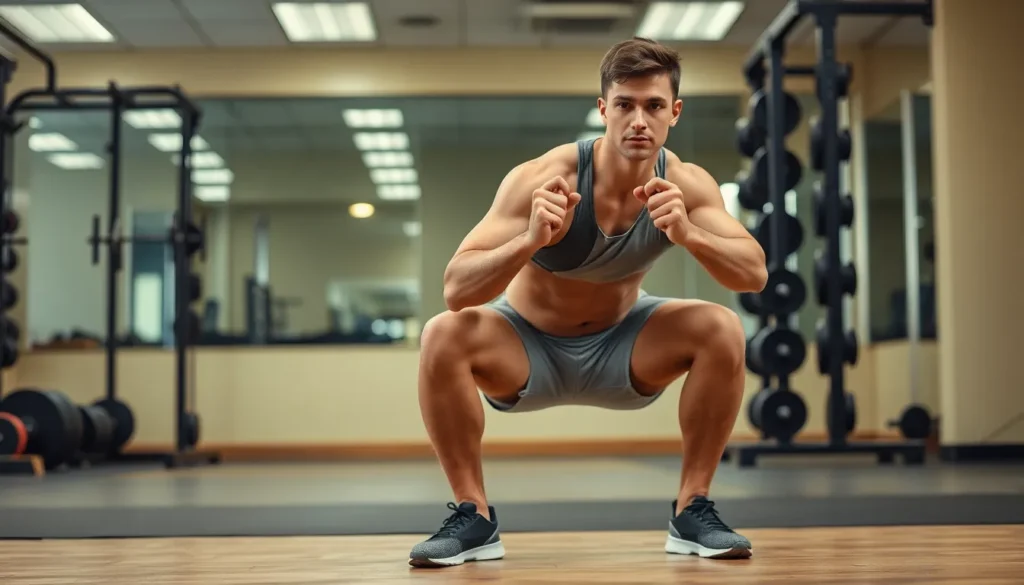Squats are like the Swiss Army knife of exercises—versatile, effective, and a little intimidating. Most people think they’re just about building strong legs, but there’s a lot more going on beneath the surface. When done right, squats engage a whole symphony of muscles, transforming your lower body into a powerhouse of strength and stability.
Table of Contents
ToggleOverview of Squats
Squats primarily target the quadriceps, hamstrings, and gluteal muscles. These muscle groups work together to support movements like standing, sitting, and jumping. Exercise execution significantly affects muscle engagement; proper form ensures maximum activation of these areas.
In addition to leg muscles, the core is also engaged during squats. A strong core stabilizes the body and maintains balance throughout the movement. Therefore, squats offer an effective way to enhance core strength alongside lower body development.
Incorporating different squat variations can further diversify muscle engagement. Front squats focus more on the quadriceps, while sumo squats emphasize the inner thighs. Bulgarian split squats, on the other hand, provide excellent unilateral training, helping correct muscle imbalances.
Squats also contribute to improved overall athletic performance. Greater lower body strength translates to better capabilities in various sports and activities. In addition, frequent practice can boost endurance and flexibility over time.
To summarize, squats engage multiple muscle groups, including the quadriceps, hamstrings, glutes, and core. Their versatility allows for targeted training, ultimately enhancing strength and functionality across various physical activities.
Primary Muscles Engaged

Squats primarily engage several major muscle groups, enhancing strength and stability. The most significant muscles targeted during squats include the quadriceps and hamstrings.
Quadriceps
Quadriceps dominate in squat movements. This group, located at the front thigh, consists of four muscles: rectus femoris, vastus lateralis, vastus medialis, and vastus intermedius. Each muscle contributes to knee extension and overall leg strength. Engaging these muscles effectively allows for explosive movements, important for athletes and fitness enthusiasts. Improved muscle activation during squats leads to better performance in daily activities, such as climbing stairs and running. A strong quadriceps group not only supports overall leg functionality but also helps balance strength between the front and back of the leg.
Hamstrings
Hamstrings play a critical role during squats. Located at the back of the thigh, this group comprises three muscles: biceps femoris, semitendinosus, and semimembranosus. These muscles work to stabilize the knee and assist in hip extension when descending and ascending in a squat position. As hamstrings engage, they counterbalance the quadriceps, promoting overall leg strength and stability. Strong hamstrings reduce the risk of injury and improve athletic performance in activities requiring sprinting and jumping. Incorporating squats into a regular workout routine effectively enhances hamstring strength and functionality.
Secondary Muscles Involved
Squats engage various secondary muscles that enhance overall strength and stability. These include the glutes, calves, and core, which contribute to proper squat mechanics and overall performance.
Glutes
The gluteal muscles play a significant role during squats. When performing this exercise, the glutes work to extend the hips, especially at the upward phase. The primary glute muscle, the gluteus maximus, is crucial for generating force and providing power during movements like jumping. Engaging the glutes not only aids in lifting heavier weights but also ensures better hip stabilization. Strong glutes promote improved posture and prevent lower back discomfort while performing various activities.
Calves
Calf muscles also participate in squats, contributing to overall stability. The gastrocnemius and soleus muscles support proper foot positioning and balance throughout the movement. These muscles assist in maintaining the body’s center of gravity, which is essential for effective squat execution. Well-developed calves enhance ankle flexibility and strength, ultimately improving squat depth and efficiency. This engagement leads to better athletic performance in sports requiring quick changes in direction.
Core
The core muscles are integral during squats, providing essential support and stability. A strong core helps maintain proper posture and alignment while executing the movement. Engaging the rectus abdominis, obliques, and transverse abdominis prevents excessive forward lean or arching of the back. This engagement not only protects the spine but also allows for more efficient energy transfer during lifts. Strengthening the core through squats enhances overall athleticism and functional fitness during everyday activities.
Benefits of Squats on Muscle Development
Squats offer numerous benefits for muscle development that extend beyond basic leg strengthening. Engaging key muscle groups, they promote comprehensive lower body strength. Quadriceps gain significant definition, offering enhanced knee extension and explosiveness. Improved performance during activities like stair climbing and running often results from this increased strength.
Hamstrings also play a vital role in muscle development through squats. Stabilizing the knee joint enhances overall leg strength and stability. Injury risk decreases as hamstrings become stronger, improving performance in activities that involve sprinting and jumping.
Gluteal muscles, especially the gluteus maximus, receive substantial activation during squats. This activation supports hip extension, power generation, and serves to enhance posture and lower back support. Incorporating squats can lead to well-defined glutes, a common fitness goal.
Calves also contribute to stability and balance during squats. These muscles assist with proper foot positioning, enhancing squat depth and form. Without strong calves, maintaining form becomes significantly more challenging.
Core muscles engage during squats, providing essential support and stability. This engagement helps maintain proper posture and alignment throughout the movement, which protects the spine and prevents injuries. Developing a strong core leads to better overall functional fitness.
Using variations like front squats and sumo squats allows for diversified muscle engagement. This variety not only prevents workout monotony but also helps correct imbalances in muscle strength and development. Incorporating different squat types enhances overall athletic performance by promoting flexibility and endurance.
Tips for Proper Squat Technique
Maintaining proper squat form is vital for maximizing effectiveness and preventing injury. Keep the feet shoulder-width apart, ensuring a stable base. Engage the core muscles before beginning the movement to support the spine.
During the descent, lower the body by bending at the hips and knees. Shoulders should remain back while the chest stays up to avoid leaning forward excessively. Focus on pushing through the heels and keeping the knees aligned with the toes to prevent strain.
Reaching parallel with the ground is ideal, but squat depth may vary based on individual flexibility and strength. Ensure the knees do not extend beyond the toes during the movement for safer execution.
For those new to squatting, using a mirror can help monitor form and alignment. Practicing with body weight or light weights allows for adjustment and can build foundational strength.
Incorporating variations, like front squats or goblet squats, can help in honing technique while targeting different muscles. Regular practice contributes to enhanced balance and stability over time.
Rest and recovery remain essential aspects of any training regimen. Listening to the body and allowing adequate recovery aids in preventing overuse injuries. Assessing form frequently ensures continued progress and muscle engagement during workouts.
Squats are a powerful exercise that engages a variety of muscle groups essential for overall strength and stability. By targeting the quadriceps, hamstrings, glutes, calves, and core, they provide a comprehensive workout that enhances performance in daily activities and athletic endeavors.
Incorporating different squat variations can further optimize muscle engagement and address any imbalances. Prioritizing proper form is crucial for maximizing benefits and minimizing injury risk. With consistent practice and attention to technique, squats can significantly contribute to improved lower body strength and functional fitness.





